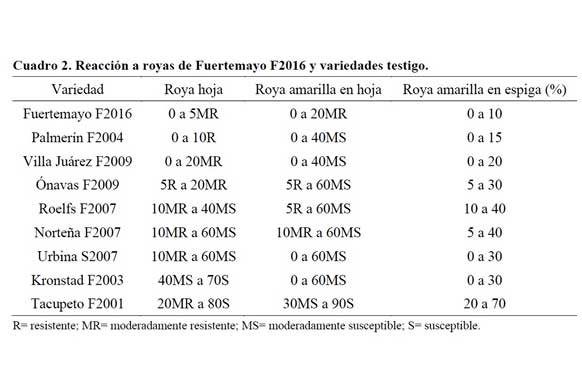Fuertemayo F2016: variety of bread wheat for irrigated sowings in Mexico
DOI:
https://doi.org/10.29312/remexca.v14i1.2806Keywords:
quality, resistance, yieldAbstract
In Mexico, the main wheat-producing regions are located in the northwest (Sinaloa, Sonora and Baja California), where 64% of national production is obtained, under irrigation conditions during the autumn-winter cycle. Fuertemayo F2016 is a spring flour wheat, released by the National Institute of Forestry, Agricultural and Livestock Research. It is of intermediate cycle, with average height of 93 cm, presents grain of medium size and white color. The line that gave rise to Fuertemayo F2016 was generated by the International Maize and Wheat Improvement Center and was evaluated by the National Institute of Forestry, Agricultural and Livestock Research in 60 environments of normal and limited irrigation. The yield under normal irrigation was 4 999 kg ha-1 and under limited irrigation was 4 576 kg ha-1, surpassing the controls by 3% (Roelfs F2007) up to 28% (Palmerín F2004). Its greatest advantage over the controls is its resistance to leaf and yellow rust, the maximum level of severity was 5 to 20%, respectively. It possesses the resistance genes of pleiotropic effect Lr46/Yr29/Sr58, Sr2/Yr30 and Lr68. It is a semi-hard grain variety, with average hectoliter weight of 79 kg hl-1 and average protein content in flour of 11.7%. For its W= 350 x 10-4 J, it is classified as having strong gluten, suitable for the mechanized baking industry and can be mixed to improve weak dough flours. It is recommended for sowings under normal and limited irrigation during the winter, in early to late dates in the states of Sinaloa, Baja California, Chihuahua, Coahuila, Nuevo León, Tamaulipas, and in early to intermediate dates in the region of El Bajío.
Downloads
References
Ávila-Quezada, G. D.; Esquivel-Fidencio, J. F.; Silva-Rojas, H. V.; Leyva-Mir, S. G.; García-Ávila, C. de J.; Noriega-Orozco, L.; Rivas-Valencia, P.; Ojeda-Barrios, D. and Melgoza-Castillo, A. M. 2018. Emerging plant diseases under a changing climate scenario: threats to our global food supply. Emirates J. Food Agric. 30(6):443-450. https://doi.org/10.9755/ejfa.2018.v30. i6.1715.
CONAGUA. 2015. Comisión Nacional del Agua. Acuerdo por el que se actualiza la disponibilidad media anual de agua subterránea de los 653 acuíferos de los Estados Unidos Mexicanos, mismos que forman parte de las regiones hidrológico-administrativas que se indican. Diario Oficial. Segunda Sección. Poder Ejecutivo. Secretaría de Medio Ambiente y Recursos Naturales. www.dof.gob.mx/nota-detalle.php?codigo=5389380&fecha=20/04/2015.
FAO. 2020. Food and Agriculture Organization of the United Nations. Crops. Rome, Italy. http://www.fao.org/faostat/en/#data/QC.
Herrera-Foessel, S. A.; Singh, R. P.; Huerta-Espino, J.; Rosewarne, G, M.; Periyannan, S. K.; Viccars, L.; Calvo-Salazar, V.; Lan, C. and Lagudah, E. S. 2012. Lr68: a new gene conferring slow rusting resistance to leaf rust in wheat. Theor. Appl. Genet. 124(8):1475-1486. https://doi: 10.1007/s00122-012-1802-1.
Huerta-Espino, J.; Singh R. P.; Germán, S.; McCallum, B. D.; Park, R. F.; Chen, W. Q.; Bhardwaj, S. C. and Goyeau, H. 2011. Global status of wheat leaf rust caused by Puccinia triticina. Euphytica. 179(1):143-160. https://doi.org/10.1007/s10681-011-0361-x.
Lan, C.; Li, Z.; Herrera, F. S. A.; Huerta, E. J.; Basnet, B. R.; Dreisigacker, S.; Ren, Y.; Lagudah, E. and Singh, R. P. 2019. Identification and mapping of two leaf rust adult plant resistance genes in durum wheat. Mol. Breed. 39(118):1-11. https://doi:10.1007 /s11032-019-1024-.
Randhawa, M. S.; Lan, C.; Basnet, B. R.; Bhavani, S.; Huerta-Espino. J.; Forrest, K. L.; Hayden, M. J. and Singh, R. P. 2018. Interactions among genes Sr2/Yr30, Lr34/Yr18/Sr57 and Lr68 confer enhanced adult plant resistance to rust diseases in common wheat (Triticum aestivum L.) line Arula. Australian J. Crop Sci. 12(6):1023-1033. https://doi: 10.21475/ajcs.18. 12.06.PNE1305.
Rodríguez, G. M. F.; García, L. E.; Huerta, E. J.; Villaseñor, M. H. E., Llaven, V. G. y González, G. M. 2020. Razas fisiológicas de Puccinia triticina E. identificadas en el norte de Sinaloa y resistencia de germoplasma. Rev. Mex. Cienc. Agríc. 11(8):1971-1977. Doi: https://doi.org/10.29312/remexca.v11i8.2574.
SIAP. 2019. Servicio de Información Agroalimentaria y Pesquera. Producción Agroalimentaria y Pesquera. https://www.gob.mx/siap/.
Singh, R. P.; Singh, P. K.; Rutkoski, J. E.; Hodson, D. P.; Xinyao, H.; Jorgensen, L. N.; Hovmoller, M. S. and Huerta-Espino, J. 2016. Disease impact on wheat yield potential and prospects of genetic control. Annu. Rev. Phytopathol. 54(1):303-322. https://doi.org/10.1146/ annurev-phyto-080615-095835.

Published
How to Cite
Issue
Section
License
Copyright (c) 2023 Revista Mexicana de Ciencias Agrícolas

This work is licensed under a Creative Commons Attribution-NonCommercial 4.0 International License.
The authors who publish in Revista Mexicana de Ciencias Agrícolas accept the following conditions:
In accordance with copyright laws, Revista Mexicana de Ciencias Agrícolas recognizes and respects the authors’ moral right and ownership of property rights which will be transferred to the journal for dissemination in open access. Invariably, all the authors have to sign a letter of transfer of property rights and of originality of the article to Instituto Nacional de Investigaciones Forestales, Agrícolas y Pecuarias (INIFAP) [National Institute of Forestry, Agricultural and Livestock Research]. The author(s) must pay a fee for the reception of articles before proceeding to editorial review.
All the texts published by Revista Mexicana de Ciencias Agrícolas —with no exception— are distributed under a Creative Commons License Attribution-NonCommercial 4.0 International (CC BY-NC 4.0), which allows third parties to use the publication as long as the work’s authorship and its first publication in this journal are mentioned.
The author(s) can enter into independent and additional contractual agreements for the nonexclusive distribution of the version of the article published in Revista Mexicana de Ciencias Agrícolas (for example include it into an institutional repository or publish it in a book) as long as it is clearly and explicitly indicated that the work was published for the first time in Revista Mexicana de Ciencias Agrícolas.
For all the above, the authors shall send the Letter-transfer of Property Rights for the first publication duly filled in and signed by the author(s). This form must be sent as a PDF file to: revista_atm@yahoo.com.mx; cienciasagricola@inifap.gob.mx; remexca2017@gmail.
This work is licensed under a Creative Commons Attribution-Noncommercial 4.0 International license.


